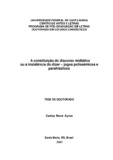| dc.creator | Ayres, Carlos Renê | |
| dc.date.accessioned | 2008-03-28 | |
| dc.date.available | 2008-03-28 | |
| dc.date.issued | 2007-11-19 | |
| dc.identifier.citation | AYRES, Carlos Renê. The constitution of media discourse or the insistence of saying: polysemous and paraphrase. 2007. 178 f. Tese (Doutorado em Letras) - Universidade Federal de Santa Maria, Santa Maria, 2007. | por |
| dc.identifier.uri | http://repositorio.ufsm.br/handle/1/3949 | |
| dc.description.abstract | The present study is based on the Discourse Analysis of the French approach and in the recent studies that have been done in Brazil in this research field. The subject of our investigation is the discourse against violence, assumed, in this research, relating the saying to negligence and sexual abuse. Our analysis follows the interpretative movements of French approach of the discourse, in which the intrinsic relation between a theory and its practice is reaffirmed. Our gesture of interpretation rest along the discursive formations
established by the discourse of the campaign produced by Rede Brasil Sul de Telecomunicações, RBS (South Brazilian Net of Communication RBS) in the years of 2003 and 2004. Love is the the best inheritance. Take care of children. We are focused on the discourses published in the newspaper Zero Hora, that belongs to the group. We
analysed the linguistic and discursive marks, trying to make emerge the ways of saying of the campaign, and its relation with the condictions of production of the discourse. We understand that the discourse of the campaign makes emerge, in the memory net, new forms of identification of the violence and those who practice it against a child. Our results reaffirm the relation with the implicits and with an imaginary that already exists. This changing in the comprehension of violence is what makes possible a rupture with the meanings. The ruptures with the conception of monsters, characters of the campaign, and its meaning is what makes possible a rupture in its net of sayings. | eng |
| dc.description.sponsorship | Coordenação de Aperfeiçoamento de Pessoal de Nível Superior | |
| dc.format | application/pdf | por |
| dc.language | por | por |
| dc.publisher | Universidade Federal de Santa Maria | por |
| dc.rights | Acesso Aberto | por |
| dc.subject | Discurso | por |
| dc.subject | Sentido | por |
| dc.subject | Memória | por |
| dc.subject | Mídia | por |
| dc.subject | Polissemia e paráfrase | por |
| dc.subject | Discourse | eng |
| dc.subject | Meaning | eng |
| dc.subject | Memory | eng |
| dc.subject | Media | eng |
| dc.subject | Metaphor | eng |
| dc.subject | Paraphrase and polysemous | eng |
| dc.title | A constituição do discurso midiático ou a insistência do dizer: jogos polissêmicos e parafrásticos. | por |
| dc.title.alternative | The constitution of media discourse or the insistence of saying: polysemous and paraphrase | eng |
| dc.type | Tese | por |
| dc.description.resumo | O presente trabalho de pesquisa se inscreve no marco teórico da Análise de Discurso (AD) de linha francesa, considerando as reformulações e ampliações que têm sido
propostas no Brasil. A temática abordada é constitutiva do discurso contra a violência, vinculando o dizer à negligência e ao abuso sexual. Nosso olhar repousa nos saberes
próprios das formações discursivas que são constitutivas do discurso midiático. Nosso corpus, constituído pela campanha O amor é a melhor herança. Cuide das Crianças ,
produzida pela Rede Brasil Sul de Telecomunicações, a RBS, bem como discursos sobre (editoriais, reportagens e colunas de opinião). Detivemo-nos na análise dos discursos
divulgados no Jornal Zero Hora, um dos veículos do grupo. Analisamos as marcas lingüístico-discursivas, buscando tornar visíveis as formas de dizer do discurso da mídia e
as relações com suas condições de produção. Através de correntes parafrásticas que assentam e também rompem com saberes já instituídos inscreve-se, na rede de memória,
novos modos de identificação do monstro e do sujeito que pratica a violência. As estruturas homogeneizadas pelo dizer comportam relações com implícitos e com um imaginário já
instituído. A representação de monstro provoca um efeito de sentido que possibilita que um outro sujeito possa simbolizar, constituindo mais um jogo de sentido. No interdiscurso,
buscamos o contínuo discursivo desencadeado pelo discurso da mídia e neste o funcionamento ideológico que se possibilita no jogo de polissemia e de paráfrases que são constitutivas do discurso da mídia. | por |
| dc.contributor.advisor1 | Scherer, Amanda Eloina | |
| dc.contributor.advisor1Lattes | http://lattes.cnpq.br/0683532681929143 | por |
| dc.contributor.referee1 | Mariani, Bethania Sampaio Corrêa | |
| dc.contributor.referee1Lattes | http://lattes.cnpq.br/3869834050601414 | por |
| dc.contributor.referee2 | Lagazzi-Rodrigues, Suzy Maria | |
| dc.contributor.referee2Lattes | http://lattes.cnpq.br/2354953198973903 | por |
| dc.contributor.referee3 | Barros, Nina Célia Almeida de | |
| dc.contributor.referee3Lattes | http://lattes.cnpq.br/6663081785223445 | por |
| dc.contributor.referee4 | Silveira, Verli Fátima Petri da | |
| dc.contributor.referee4Lattes | http://lattes.cnpq.br/4907455690392249 | por |
| dc.creator.Lattes | http://lattes.cnpq.br/1639853030067696 | por |
| dc.publisher.country | BR | por |
| dc.publisher.department | Letras | por |
| dc.publisher.initials | UFSM | por |
| dc.publisher.program | Programa de Pós-Graduação em Letras | por |
| dc.subject.cnpq | CNPQ::LINGUISTICA, LETRAS E ARTES::LETRAS | por |


